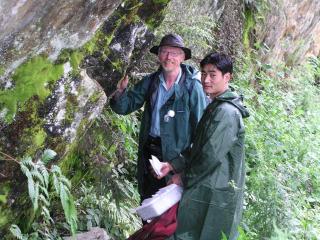Inventory of Bryophytes in the Gaoligong Shan, Yunnan, China
Published on 6 October 2010 in Ecosystems and biodiversity

Introduction
The Biotic Survey of Gaoligong Shan, Yunnan is one of the biggest exploratory biological surveys ever undertaken in China, and has resulted in collection over the years 2002 to 2007 of over 25,000 fully documented plant specimens as well as countless insects and other invertebrates. These specimens and rigorous supporting data are available to scientists worldwide.
The 585km long Gaoligong Shan is the dividing range between
The 5-year field programme is now complete, and the participating research groups in
Key Points
Royal Botanical Garden Edinburgh (RBGE) is a partner in the project for flowering plants and bryophytes and nine staff have joined one or more expeditions. Bryophytes have been collected by David Long (RBGE) and Jim Shevock (California Academy of Sciences). Bryological field work to date has covered a range of vegetation types from lowland subtropical evergreen forest to the alpine zone up to 3700m, mostly between the Nu Jiang (
Research Undertaken
During the years 2002 to 2007, field work was prioritized and bryophyte collections were made on ten expeditions. Funding was provided by a grant from the US National Science Foundation awarded to our collaborators, the California Academy of Sciences. Expedition logistics were planned at the Kunming Institute of Botany and expeditions lasted from four to six weeks, using vehicle transport where possible or trekking on foot with porters to remote areas.
All bryophyte specimens were collected in paper packets and liverworts also in silica gel for DNA extraction. Specimens were dried using electric fans. Accurate locality data using GPS were recorded along with detailed ecological data for each collection. Dry specimens were shipped to
Specimens were distributed worldwide to specialists for taxonomic study which will be on-going for many years. Publications to date include two genera (the moss Shevockia and liverwort Hamatostrepta) and several species new to science. Ultimately a floristic guide and checklist are planned for the mountain range when a significant proportion of collections are fully researched.
Policy Implications
The research has gathered a very large new dataset on the rich biodiversity of a global hotspot for bryophytes and other plants. This in turn should help to protect the forest and alpine habitats of Gaoligong Shan from destructive development. Recording precise data on biodiversity is a key element of future research on the impact of climate change on mountain ranges such as Gaoligong Shan.
Author
Dr David Long, Royal Botanic Garden Edinburgh d.long@rbge.ac.uk





